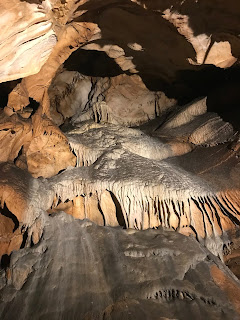West Norwegian Fjords
The West Norwegian Fjords include the Geirangerfjord and Nærøyfjord and were inscribed onto UNESCO's World Heritage list on July 14, 2005. Due to time constraints, I was only able to visit the Nærøyfjord.
First, we should understand what a fjord is. According to fjords.com, "Fjords are found in locations where current or past glaciation extended below current sea level. A fjord is formed when a glacier retreats, after carving its typical U-shaped valley, and the sea fills the resulting valley floor."
After spending a day in Bergen, I set out on a fjord tour of the Nærøyfjord in order to obtain answers to some of my research questions. My journey began in Bergen, taking a train from Bergen to Voss. The train ride lasted about an hour. I was floored by the sites outside my window. Norway is absolutely beautiful. Extravagant nature is everywhere and everything is so clean and pure. Normally, I am on my phone or doing Homework during a train/plane/bus ride. However, this train ride was an exception. One would be foolish to not look out their window and observe the scenery. After arriving in Voss, I boarded a bus that took me to Gudvangen which is a small village with a population of 120 people situated at the head of the Nærøyfjord.
Views from the Bus
Exiting the bus, I boarded the fjord cruise boat, where we cruised the Nærøyfjord for two hours. The fjord is simply breathtaking. I have never seen anything like it in my entire life. The pictures that I am posting do not even properly display it's beauty. Being surrounded by tall mountains, waterfalls, forests, and canyons was dream-like.
The boat took us to the end of the Nærøyfjord which is in Flåm. Here, I had a little over an hour to grab some lunch and explore the tiny town. I went into a museum in hopes to find information for my project. However, the museum was strictly for the history of the Flåm railway. I then went to the Visitor's Center. Here I found many helpful displays about the fjords connection with UNESCO as well as some history of the Nærøyfjord. I asked at the counter if someone could provide me with information about more history and how the fjords are preserved. The lady helping me did not have or know this information. She gave me a pamphlet of the hiking trails along the Nærøyfjord which was not helpful at all, but still a kind gesture. The information and free pamphlets in the Visitor Center were quite helpful for my research though. I then left Flåm and went to Myrdal which was another hour train ride. Again, the scenery was amazing. This train ride had a TV and a speaker that provided passengers with interesting information about the Flåm railway and the scenery. At one point during the journey, the train stopped and everyone was permitted to exit the train to see a huge waterfall and take pictures. Suddenly, music started blaring a women appeared at the top of the waterfall on a rock and began to dance. It did not even look real - something from a movie. Once I arrived in Myrdal, it was a two hour train ride back to Bergen. I was extremely impressed and satisfied with this tour.
Waterfall in Myrdal
Here are my research questions and the answers that I obtained from various pamphlets, museum, tourism, and visitor centers' signs, and talking with employees and natives:
The West Norwegian Fjords fulfill two of the natural scientific criteria for UNESCO: (1) "to contain superlative natural phenomena or areas of exceptional natural beauty and aesthetic importance, (2) to be outstanding examples representing major stages of earth's history, including the record of life, significant on-going geological processes in the development of landforms, or significant geomorphic or physiographic features."
The Nærøyfjord Area: The area has a wide variety of landscapes ranging from waterfalls, woods, rivers, canyons, and mountains. The Nærøyfjord is 17 km long and 250 wide at its narrowest point. The Nærøyfjord part of the West Norwegian Fjords includes the villages, the protected areas of the Nærøyfjord as well as parts of the Aurlandsfjord.
During my tour, it was mentioned that, "Norway is dedicated to protecting, preserving, making known and passing on this heritage to future generations." The Nærøyfjord area is protected as an IUCN Category V "Protected Landscape." Many of the smaller areas within the Nærøyfjord are considered as a Category I "Strict Nature Reserve." The Norwegian Nature Diversity Act provides long-term protection for the entire Nærøyfjord. The Nærøyfjord is 85% private land, but the inhabited parts are still controlled by various plans and acts (building, planning, local, development, municipal, county, etc.). An advisory council meets regularly in order to effectively maintain the West Norwegian fjords. Additionally, several declarations are signed to ensure that measures will be taken to endure and protect the natural state of these fjords.
A small village alongside the Nærøyfjord
I was unsure about what kind of natural hazards/impacts the fjords faced. I learned that mining and underground quarrying is a deep concern. After reading about this topic, I found that because these fjords are highly protected, any more extensive mining or quarrying is prohibited in order to protect the fjord. I am still curious if global warming has any impact on the fjords.
Tourism is definitely an issue that I was most interested in. People such as my self, come to Norway solely to see these magnificent fjords. Thousands every day, float across the Nærøyfjord. I presume that all this tourism would have some sort of negative effect on the fjord. After observing and talking with one of the captains of the boat, I learned that the tourism does not really negatively impact the fjord. The only access that tourists have to the Nærøyfjord is by boat. These boats do not disturb the natural habitat as well as the people on the boats.










Comments
Post a Comment